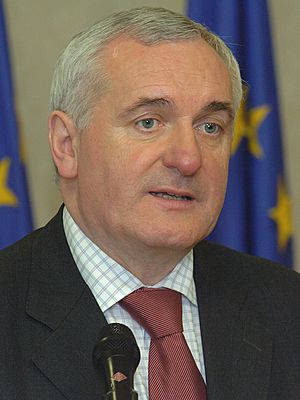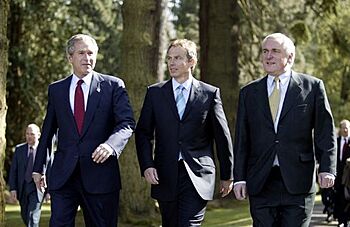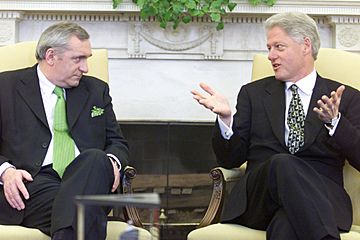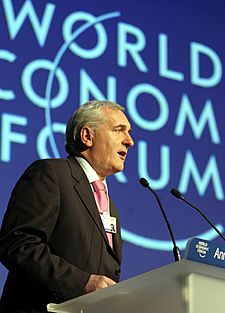Bertie Ahern facts for kids
Quick facts for kids
Bertie Ahern
|
|
|---|---|

Ahern in 2006
|
|
| Taoiseach | |
| In office 26 June 1997 – 7 May 2008 |
|
| President | |
| Tánaiste |
|
| Preceded by | John Bruton |
| Succeeded by | Brian Cowen |
| Leader of Fianna Fáil | |
| In office 19 December 1994 – 6 May 2008 |
|
| Deputy |
|
| Preceded by | Albert Reynolds |
| Succeeded by | Brian Cowen |
| Leader of the Opposition | |
| In office 15 December 1994 – 26 June 1997 |
|
| Taoiseach | John Bruton |
| Preceded by | John Bruton |
| Succeeded by | John Bruton |
| Tánaiste | |
| In office 19 November 1994 – 15 December 1994 |
|
| Taoiseach | Albert Reynolds |
| Preceded by | Dick Spring |
| Succeeded by | Dick Spring |
| Deputy leader of Fianna Fáil | |
| In office 10 February 1992 – 19 November 1994 |
|
| Leader | Albert Reynolds |
| Preceded by | John Wilson |
| Succeeded by | Brian Cowen |
| Minister for Arts, Culture and the Gaeltacht | |
| In office 19 November 1994 – 15 December 1994 |
|
| Taoiseach | Albert Reynolds |
| Preceded by | Michael D. Higgins |
| Succeeded by | Michael D. Higgins |
| Minister for Industry and Commerce | |
| In office 4 January 1993 – 12 January 1993 |
|
| Taoiseach | Albert Reynolds |
| Preceded by | Pádraig Flynn |
| Succeeded by | Ruairi Quinn |
| Minister for Finance | |
| In office 14 November 1991 – 15 December 1994 |
|
| Taoiseach |
|
| Preceded by | Albert Reynolds |
| Succeeded by | Ruairi Quinn |
| Minister for Labour | |
| In office 10 March 1987 – 14 November 1991 |
|
| Taoiseach | Charles Haughey |
| Preceded by | Gemma Hussey |
| Succeeded by | Michael O'Kennedy |
| Minister of State | |
| 1982 | Government Chief Whip |
| 1982 | Defence |
| Lord Mayor of Dublin | |
| In office 24 June 1986 – 26 June 1987 |
|
| Preceded by | Jim Tunney |
| Succeeded by | Carmencita Hederman |
| Teachta Dála | |
| In office June 1981 – February 2011 |
|
| Constituency | Dublin Central |
| In office June 1977 – June 1981 |
|
| Constituency | Dublin Finglas |
| Personal details | |
| Born |
Bartholomew Patrick Ahern
12 September 1951 Drumcondra, Dublin, Ireland |
| Political party | Fianna Fáil (1965–2012; since 2023) |
| Spouse |
Miriam Kelly
(m. 1975; sep. 1992) |
| Children |
|
| Relatives |
|
| Alma mater | College of Commerce, Rathmines |
| Signature | |
Bartholomew Patrick "Bertie" Ahern (born 12 September 1951) is an Irish former politician. He was the leader of the Fianna Fáil political party from 1994 to 2008. He also served as Taoiseach (Ireland's Prime Minister) from 1997 to 2008.
Ahern was a Teachta Dála (TD), which is a member of the Irish Parliament, from 1977 to 2011. Before becoming Taoiseach, he was the Leader of the Opposition from 1994 to 1997. He also held important roles like Lord Mayor of Dublin (1986–1987) and Minister for Finance (1991–1994).
Under Ahern's leadership, Fianna Fáil led three coalition governments. He is the second-longest serving Taoiseach in Ireland's history. He stepped down as Taoiseach in May 2008 after questions arose about payments he received from developers. He later left the Fianna Fáil party but rejoined in February 2023.
Contents
Early Life and Education
Ahern was born in Drumcondra, Dublin, in 1951. He was the youngest of five children. His parents, Con and Julia Ahern, were from County Cork. His father worked as a farm manager. Bertie's brother, Noel, also became a politician.
Ahern's father, Con, had a background in farming and was involved in the Irish Civil War. He supported Éamon de Valera and was a member of the IRA.
Bertie Ahern went to St. Patrick's National School and St. Aidan's Christian Brothers school. He studied at the College of Commerce, Rathmines, which is part of the Dublin Institute of Technology. While some biographies mentioned other universities, these universities do not have records of him being a student there. He later worked in the Accounts Department of the Mater Hospital, Dublin.
Ahern loves sports. He is a big fan of Dublin GAA and often watches their matches. He also supports Manchester United F.C. and attends their games.
Starting in Politics
Ahern first got involved in politics in 1965, helping with a Fianna Fáil election campaign. He joined the party at 17. In the 1977 Irish general election, he was elected as a Teachta Dála (TD) for the Dublin Finglas constituency. He was also elected to the Dublin City Council in 1979.
He became very popular with voters in his Dublin Central area. People often voted for him first, and his party members would then get votes from his extra support.
In 1979, Ahern supported Charles Haughey to become the leader of Fianna Fáil. After Haughey won, Ahern was appointed Assistant-Government Chief Whip. He later became the Government Chief Whip in 1982.
When Fianna Fáil was not in government for five years, Ahern became the party's spokesperson on Labour issues. In 1986, he became Lord Mayor of Dublin. During this time, he helped organize the Dublin Millennium festival.
Working in Government
Minister for Labour
In 1987, Fianna Fáil returned to power. Ahern was made Minister for Labour. He played a key role in helping Ireland's economy. He helped create agreements between unions and employers, which were known as the 'Irish model'. These agreements helped the economy grow.
In 1989, Fianna Fáil formed a coalition government with another party. Ahern kept his job as Minister for Labour. He continued to work on economic agreements.
Minister for Finance
In November 1991, Ahern became Minister for Finance. This is a very important role, managing the country's money. He publicly supported Charles Haughey during a leadership challenge.
In 1992, Charles Haughey resigned as Taoiseach. Ahern was encouraged to become the next leader but decided not to run. Albert Reynolds became the new leader, and Ahern remained Minister for Finance.
In 1994, the government changed again. Ahern briefly served as Tánaiste (Deputy Prime Minister). However, the government soon fell apart. Reynolds resigned as Taoiseach and Fianna Fáil leader.
Leading Fianna Fáil
Ahern became the leader of Fianna Fáil on 19 December 1994. He was the first leader to be chosen without anyone else running against him since 1959.
It was expected that Fianna Fáil would form a new government with the Labour Party. However, the Labour Party decided not to join with Fianna Fáil. This meant Ahern became the Leader of the Opposition.
In the 1997 Irish general election, Fianna Fáil focused on Ahern's popularity. His party gained seats, and he formed a government with the Progressive Democrats and some independent politicians. On 26 June 1997, at 45 years old, Ahern became the youngest Taoiseach since W. T. Cosgrave.
Time as Taoiseach
First Term (1997–2002)
Early Challenges

Ahern's first government faced some challenges. There were questions about how some ministers were appointed. Also, a former minister, Ray Burke, admitted to receiving a payment and resigned. These issues led to the government setting up special investigations called tribunals.
A major positive event in his first term was the renewal of the Provisional IRA ceasefire. This helped restart peace talks in Northern Ireland.
Working for Peace
A big success for Ahern was his part in creating the Good Friday Agreement. This agreement, signed on 10 April 1998, helped bring peace to Northern Ireland. It set up a way for different political groups to share power peacefully. The agreement was supported by the British and Irish governments and the people of both Ireland and Northern Ireland.
This peace process also led to a strong friendship between Ahern and former British Prime Minister Tony Blair. They both received awards for their work on the Good Friday Agreement.
Economic Growth
Ahern's first time as Taoiseach was a period of fast economic growth in Ireland, known as the Celtic Tiger. This meant more jobs and a better standard of living for many people. The government had more money to spend, and they made some tax changes. However, there were also challenges with building enough hospitals and improving transport.
Later, in 2008, the economy slowed down, and Ireland faced an economic crisis. Ahern later said that a decision he made in 2001 to create the Financial Regulator was one of the reasons for problems in the Irish banking system.
2002 Election Victory
The government completed its full term. In the 2002 Irish general election, Ahern's coalition of Fianna Fáil and the Progressive Democrats was re-elected. This was the first time a government had been re-elected in Ireland since 1969.
Second Term (2002–2007)

After the 2002 election, the government faced criticism for needing to make financial cutbacks, which seemed to go against their election promises. There was also debate about US military planes refueling at Shannon Airport during the 2003 invasion of Iraq, as Ireland has a policy of neutrality.
Despite these issues, the government made progress in other areas. They introduced a ban on smoking in workplaces in March 2004. Transport improved with the launch of the Luas light rail system in Dublin and the building of new motorways.
In November 2004, Ahern celebrated ten years as leader of Fianna Fáil. In April 2006, he became the second longest serving Taoiseach.
In 2004, Ahern also led the European Council. During this time, EU leaders agreed on a new European Constitution, and ten new countries joined the EU.
Financial Questions
Ahern's reputation faced challenges due to questions about payments he received from businessmen in 1994. These payments became public knowledge later. He was questioned by a special investigation called the Mahon Tribunal.
In May 2007, he became the first Irish leader to speak to both the Parliament of the United Kingdom and the United States Congress.
2007 Election
Ahern hoped to win a third general election in 2007. Despite the questions about his finances, his party performed well. Fianna Fáil won 78 seats, and he formed a new government.
Third Term (2007–2008)
After the 2007 election, Ahern was elected Taoiseach for a third time. He led a coalition government that included Fianna Fáil, the Green Party, and the Progressive Democrats, with support from some independent TDs. This was the first time Fianna Fáil had formed a government with the Green Party.
Questions about Ahern's personal finances continued to be a major topic. Polls showed that many people did not believe his explanations about the money he received. This caused some tension within his government.
On 2 April 2008, Ahern announced that he would resign as Taoiseach and leader of Fianna Fáil on 6 May 2008. On his last day as Taoiseach, he opened a visitors' center with the First Minister of Northern Ireland, Ian Paisley.
Life After Politics
On 30 December 2010, Ahern announced that he would not run in the 2011 Irish general election. He said he had planned to step down before he turned 60.
He mentioned that he wished he had seen the banking crisis coming. He also said that no economists had warned him about it.
After leaving politics, Ahern continued to be involved in international work. He was appointed to an international advisory group on conflict resolution. He also became a board member of Co-operation Ireland, a charity that promotes peace.
He wrote a sports column for a newspaper and gave many speeches, earning money from these engagements. He also visited China regularly and gave lectures.
In February 2023, Ahern rejoined the Fianna Fáil party.
Legacy
Historians and commentators have different views on Ahern's time as Taoiseach. Some praise his work on the Good Friday Agreement and his ability to unite his party. Others question whether he made the most of Ireland's economic boom to improve public services like health and education.
Journalist Stephen Collins noted that it was unclear if Ahern was very clever politically or if he just struggled to make decisions. Michael O'Leary, the head of Ryanair, criticized Ahern, saying he "squandered the wealth of a generation."
A TV series called Bertie was made about his life and career.
Personal Life
Family Life
In 1975, Ahern married Miriam Kelly. They have two daughters: Georgina and Cecelia. Georgina married Nicky Byrne from the pop group Westlife. Cecelia is a well-known author and screenwriter.
Ahern and his wife separated in 1992. He was later in a relationship with Celia Larkin until 2003.
Religious Beliefs
Ahern is a practicing Roman Catholic. He attends Mass regularly. He has spoken about his faith and how it guides him. He once shared that he and former DUP leader Ian Paisley connected over their shared faith during a meeting.
Governments Led by Ahern
- 25th government of Ireland (June 1997 – June 2002)
- 26th government of Ireland (June 2002 – June 2007)
- 27th government of Ireland (June 2007 – May 2008)
See also
 In Spanish: Bertie Ahern para niños
In Spanish: Bertie Ahern para niños



